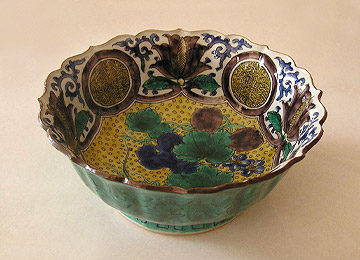| Kutani
ware. The term was used from around 1803, but only the original, ko-kutani
古九谷 (old Kutani) was actually made at the Kutani kiln in Kutani 九谷, Ishikawa prefecture.
The ware is famous for its distinctive five-color palette of red, green, yellow,
purple and Prussian blue rendered in bold designs of overglaze enamels. The motifs
are first outlined with cobalt blue, manganese black, and iron red and then enamels
are applied over them. After firing, the glasslike transparency of the colors
allow the underdrawing to become part of the design. In the mid-17c, Maeda Toshiharu
前田利治 (1618-60), head of the Daishouji 大聖寺 clan, found kaolinic clay for making
porcelain in his domain in Kutani. Maeda's retainers Gotou Saijirou 後藤才治郎 and
Tamura Gonzaemon 田村権左衛門 (act. about 1655-1703) set up kilns in the villages of
Kutani and Suisaka 吸坂 to make tea-ceremony utensils. Gotou's son Tadakiyo 忠清 was
sent to Arita 有田 in Kyuushuu 九州 to learn porcelain-making techniques. He returned
with an exiled potter from Ming China and together they produced what is now termed
ko-kutani. Around 1694 the Kutani kilns fell into disuse until 1804 when
Aoki Mokubee 青木木米 (1767-1833) came to Kutani and fired a kiln in Kasugayama 春日山.
His work inspired the construction of kilns in surrounding areas and re-established
Kutani ware, the so-called saikou kutani 再興九谷 (revised Kutani). Kutani
ware was exported in great numbers to Europe beginning at the end of the 19c. |

